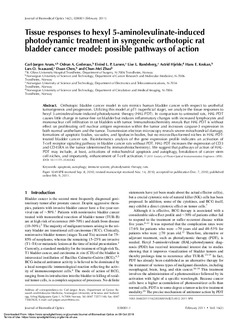Tissue responses to hexyl 5-aminolevulinate-induced photodynamic treatment in syngeneic orthotopic rat bladder cancer model: possible pathways of action
Arum, Carl-Jørgen; Gederaas, Odrun Arna; Larsen, Eivind La Puebla; Randeberg, Lise Lyngsnes; Hjelde, Astrid; Krokan, Hans Einar; Svaasand, Lars O.; Chen, Duan; Zhao, Chun-Mei
Journal article, Peer reviewed
Published version

Åpne
Permanent lenke
http://hdl.handle.net/11250/2621390Utgivelsesdato
2011Metadata
Vis full innførselSamlinger
Sammendrag
Orthotopic bladder cancer model in rats mimics human bladder cancer with respect to urothelial tumorigenesis and progression. Utilizing this model at pT1 (superficial stage), we analyze the tissue responses to hexyl 5-aminolevulinate-induced photodynamic therapy (HAL-PDT). In comparison to untreated rats, HAL-PDT causes little change in tumor-free rat bladder but induces inflammatory changes with increased lymphocytes and mononuclear cell infiltration in rat bladders with tumor. Immunohistochemistry reveals that HAL-PDT is without effect on proliferating cell nuclear antigen expression within the tumor and increases caspase-3 expression in both normal urothelium and the tumor. Transmission electron microscopy reveals severe mitochondrial damage, formations of apoptotic bodies, vacuoles, and lipofuscin bodies, but no microvillus-formed niches in HAL-PDT-treated bladder cancer rats. Bioinformatics analysis of the gene expression profile indicates an activation of T-cell receptor signaling pathway in bladder cancer rats without PDT. HAL-PDT increases the expression of CD3 and CD45RA in the tumor (determined by immunohistochemistry). We suggest that pathways of action of HAL-PDT may include, at least, activations of mitochondrial apoptosis and autophagy, breakdown of cancer stem cell niches, and importantly, enhancement of T-cell activation.